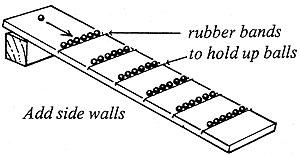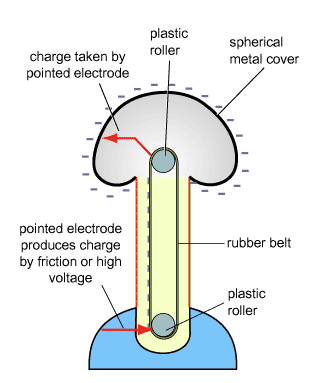Sparks in Air
Claimed by Amani Petersen(Fall 2016) Edited by Pearl Ruparel(Fall 2017) Edited by Christian Grupp(Fall 2023)
Introduction
Electric spark is a commonly observed phenomenon that occurs when a strong electric field ionizes molecules of a normally neutral substance such as air. By breaking down the molecules into ions, the electric field creates a pathway of charge in which current can easily flow. Regularly identified by their sudden bright light and popping sound, sparks have been a point of interest for humans since the beginning of recorded history.
The Physical Model
At a high level of abstraction, the occurrence of a spark is marked by three phases: the ionization of air particles, the propagation of the electric field in the air gap, and the neutralization of charges due to cancellation. These are no finite boundaries between these phases, although there is a general order to them, despite how quickly a spark occurs.
Ionization of Air
In air, there is always a chance that ionized particles will naturally exist without the presence of a strong electric field. However, air molecules (most notably Nitrogen and Oxygen) are very stable, so these ions do not make up a significant portion of all air molecules in our atmosphere. These stable molecules require a relatively large amount of energy to separate them from their electrons. Typically, collisions between air particles do not impart enough energy to ionize them -- separate them from some of their electrons.
However, in the presence of a strong electric field, ions in the atmosphere accelerate to very high speeds, gaining relatively large amounts of kinetic energy. In a strong enough electric field, these ions gain enough Kinetic energy to break apart air molecules when upon collision. The separation of the electrons from these air molecules creates two more ions: one negative (the electron) and one positive (the N2+ or O2+)
Propagation of the Electric Field
A static electricity spark is a sudden flow of electric current across an air gap, heating the air to very high temperatures, cause it to glow. The size of the spark depends on the separation of the sources of electrical charges and their potential difference in voltage. A spark may be only a few millimeters, several meters or even kilometers in length. Because electric fields are strongest near each of the two opposite charges, the chain reaction of ionization starts there. The new ions created through collisions with the ions accelerated by the electric field also accelerate due to the electric field. These new ions can then cause more air particles to ionize by striking them at high speeds.
 [1]The single ball causes multiple balls to "ionize", which, in turn, cause more balls to roll down the ramp.
[1]The single ball causes multiple balls to "ionize", which, in turn, cause more balls to roll down the ramp.
The negatively charged ions move towards the positively charged object that started the spark, and the positively charged ions move towards the negatively charged object. As this happens, the charge distribution in the air between the two charged objects changes. Before the spark began, the electric field emanated from the two charged objects. As ions begin to form, the electric field also emanates in part from the ionized air. This causes the electric field between the two charged object to become more uniform, much like what occurs in a wire when a circuit is closed. Eventually, the chain reactions coming from each charged object meet in the middle, and the "circuit" is complete.
Neutralization of Charges
The molecules of the air are now sufficiently ionized to carry a current. The electrons in the gap move relatively rapidly toward the positively charged object, while the positive ions move very slowly towards the negatively charged object, due to the differences in their masses. As the ions hit the charged surfaces to which they are attracted, they combine with oppositely charged particles on that object's surface. When this happens, the charge on each object diminishes due to the cancellation of fields. Soon, there is no longer enough charge on the objects to accelerate the ions enough to maintain an ionized air gap. As the charged particles move through, the air, they are constantly recombining with other ions in the process of random motion, before being again knocked apart by an accelerated charge. Sparks produce light because when molecules recombine, they move to a lower energy state, and emit the difference in energy as a photon. These continual reactions produce a lot of heat, which cases the air gap to rapidly expand and make the sound we hear when a spark occurs.
Van de Graaff Generator
Van de Graaff generator can produce a voltage of over 10 million volts on its spherical cover. It has many uses. Such as in nuclear physics, the high voltage can be used to accelerate various kinds of charged particles, like protons, electrons etc. Moreover, the generator can be used to demonstrate many interesting phenomena of static electricity such as producing an electric spark. Through these phenomena, we can understand more about the nature of static electricity.A Van de Graaf static electric generator can produce over 400,000 volts of potential energy. This is sufficient to send a spark from the generator globe to another metal sphere over 50 cm or 20 inches away. High voltages can be estimated roughly by how far they will make a spark jump in air. Static charges that jump a centimeter general involve 10,000 – 30,000 V.
 [2] This shows how a Van de Graaff Generator works
[2] This shows how a Van de Graaff Generator works
Producing the Electric Spark
When a small grounded metal ball is placed close to the spherical cover of the generator, the strong electric field will cause the charge to leap towards the ball, producing a large amount of ions and electrons in air. Since the energy of the ions are higher than that of the neutral molecules, they will release their energy spontaneously and produce a spark, which is a discharge in air. One of the most common examples of this is lightning which is a discharge phenomenon in which charge leaps from a cloud to another or to the ground.
Youtube Video of how Van de Graaff can be used to create electric sparks: https://www.youtube.com/watch?v=VebB-D61XDM
A Mathematical Model
Let's run through a mathematical model of the situation to make sure that the numbers match up with our observations. How much of an electric field is required to accelerate the electrons enough to cause a chain reaction? At ground level, the average distance an air particle can travel before it makes contact with another is [math]\displaystyle{ 1E-6m }[/math][3]. This is known as the mean free path. Over this small of a distance, we can assume that the electric field will be roughly uniform. If we know that the average ionization energy for an air molecule is roughly [math]\displaystyle{ 2E-18J }[/math][4], then we can calculate what electric field magnitude will be necessary to cause a spark.
[math]\displaystyle{ E |\!-\!e| }[/math] constitutes the force applied to a free electron by the electric field, so
[math]\displaystyle{ E e d }[/math] must be the kinetic energy imparted to the electron over the mean free path, where [math]\displaystyle{ d }[/math] is the mean free path.
[math]\displaystyle{ E e d = K }[/math]
[math]\displaystyle{ E = {\frac{K}{ed}} }[/math]
[math]\displaystyle{ E = {\frac{(2E-18J)}{(1.6E-19C)(1E-6m)}} }[/math]
[math]\displaystyle{ E = 1.2E7{\frac{N}{C}} }[/math]
The experimentally observed value for [math]\displaystyle{ E }[/math] is [math]\displaystyle{ 3E6 }[/math]
Should our answer be regarded as accurate? Knowing that air molecules, on average, already carry some kinetic energy before being stricken by accelerated ions, and that some of the ions will travel a much longer distance than the mean free path before hitting an air molecule, it is not surprising that our simplified calculation overestimates the amount of field required to cause a spark.
Computational Model
One can use a computational model to represent the vector at a specific point for the electric charge of an electric spark as in emanates from a point. https://glowscript.org/#/user/Christian_Grupp/folder/MyPrograms/program/LightningStrike.
History
While the presence of lightning and other electrical phenomena have made electrical sparks a core element of human history, the first person to discover that the manipulation of objects can be used to produce sparks, (by the rubbing of amber and cloth), is the ancient Greek philosopher Thales of Miletus. This observation is credited with helping to discover the existence of electrical sparks. Electrical sparks were known to the Greeks, but it was not until 1671 that the eminent mathematician and philosopher Leibniz codified these discoveries.
Looking ahead in time, in 1716, Sir Isaac Newton reported seeing "miniature sheet lightning," a phenomenon that Benjamin Franklin would later report seeing as well. Franklin was a pivotal player in the study of electricity and made significant advances in the area. Stephen Gray's discovery of metal conductivity in 1729 laid the groundwork for our understanding of how electricity may move through various materials.
An important discovery was made in 1745 when Albrecht von Haller discovered that lightning tends to follow metal things, just as the sparks seen in previous studies. Building on this realization, Benjamin Franklin developed his concepts for an experiment that would profoundly advance our knowledge of electricity in 1749. By 1750, Franklin had proposed the ground-breaking idea of the lightning rod, realizing its ability to protect buildings from lightning's destructive power.
Benjamin Franklin's ability to extract sparks from clouds during thunderstorms is one of his most famous experiments, and it served as additional evidence of his contributions to the understanding of electricity. Over decades, the understanding of electric sparks in the air developed through a series of observations, tests, and ground-breaking concepts. Each important person contributed significantly to the changing history of electrical phenomena.
Connectedness
[5] One of the most common displays of sparks in air occur during thunderstorms in the form of lightning. Lightning is essentially a large spark between the earth's surface and the surface of a cloud. [6]Ionized air is also known as plasma, which most notably occurs as a result of the fusion which the sun undergoes as a result of it's inward gravitational pressure.
References
[7] Nuffield Foundation: Sparks In Air
[8] Saint Benedict Saint John's University: Electrical Discharges
[9] N. Kyzhanovsky: Mapping the History of Electricity
[10] Physics Q&A: Van de Graaff generator
[11] UCLA Physics: Van de Graaff
[12] Youtube Video: Van de Graaff Generator